Developer Guide
- Setting up, getting started
- Design
- Implementation
- Documentation, logging, testing, configuration, dev-ops
- Appendix: Requirements
- Appendix: Instructions for manual testing
Setting up, getting started
Refer to the guide Setting up and getting started.
Design
Architecture

The Architecture Diagram given above explains the high-level design of the App. Given below is a quick overview of each component.
.puml files used to create diagrams in this document can be found in the diagrams folder. Refer to the PlantUML Tutorial at se-edu/guides to learn how to create and edit diagrams.
Main has two classes called Main and MainApp. It is responsible for,
- At app launch: Initializes the components in the correct sequence, and connects them up with each other.
- At shut down: Shuts down the components and invokes cleanup methods where necessary.
Commons represents a collection of classes used by multiple other components.
The rest of the App consists of four components.
-
UI: The UI of the App. -
Logic: The command executor. -
Model: Holds the data of the App in memory. -
Storage: Reads data from, and writes data to, the hard disk.
Each of the four components,
- defines its API in an
interfacewith the same name as the Component. - exposes its functionality using a concrete
{Component Name}Managerclass (which implements the corresponding APIinterfacementioned in the previous point.
For example, the Logic component (see the class diagram given below) defines its API in the Logic.java interface and exposes its functionality using the LogicManager.java class which implements the Logic interface.

How the architecture components interact with each other
The Sequence Diagram below shows how the components interact with each other for the scenario where the user issues the command delete 1.

The sections below give more details of each component.
UI component

API :
Ui.java
The UI consists of a MainWindow that is made up of parts e.g.CommandBox, ResultDisplay, PersonListPanel, StatusBarFooter etc. All these, including the MainWindow, inherit from the abstract UiPart class.
The UI component uses JavaFx UI framework. The layout of these UI parts are defined in matching .fxml files that are in the src/main/resources/view folder. For example, the layout of the MainWindow is specified in MainWindow.fxml
The UI component,
- Executes user commands using the
Logiccomponent. - Listens for changes to
Modeldata so that the UI can be updated with the modified data.
Logic component

API :
Logic.java
-
Logicuses theDeliveryListParserclass to parse the user command. - This results in a
Commandobject which is executed by theLogicManager. - The command execution can affect the
Model(e.g. adding a customer). - The result of the command execution is encapsulated as a
CommandResultobject which is passed back to theUi. - In addition, the
CommandResultobject can also instruct theUito perform certain actions, such as displaying help to the user.
Given below is the Sequence Diagram for interactions within the Logic component for the execute("delete 3") API call.
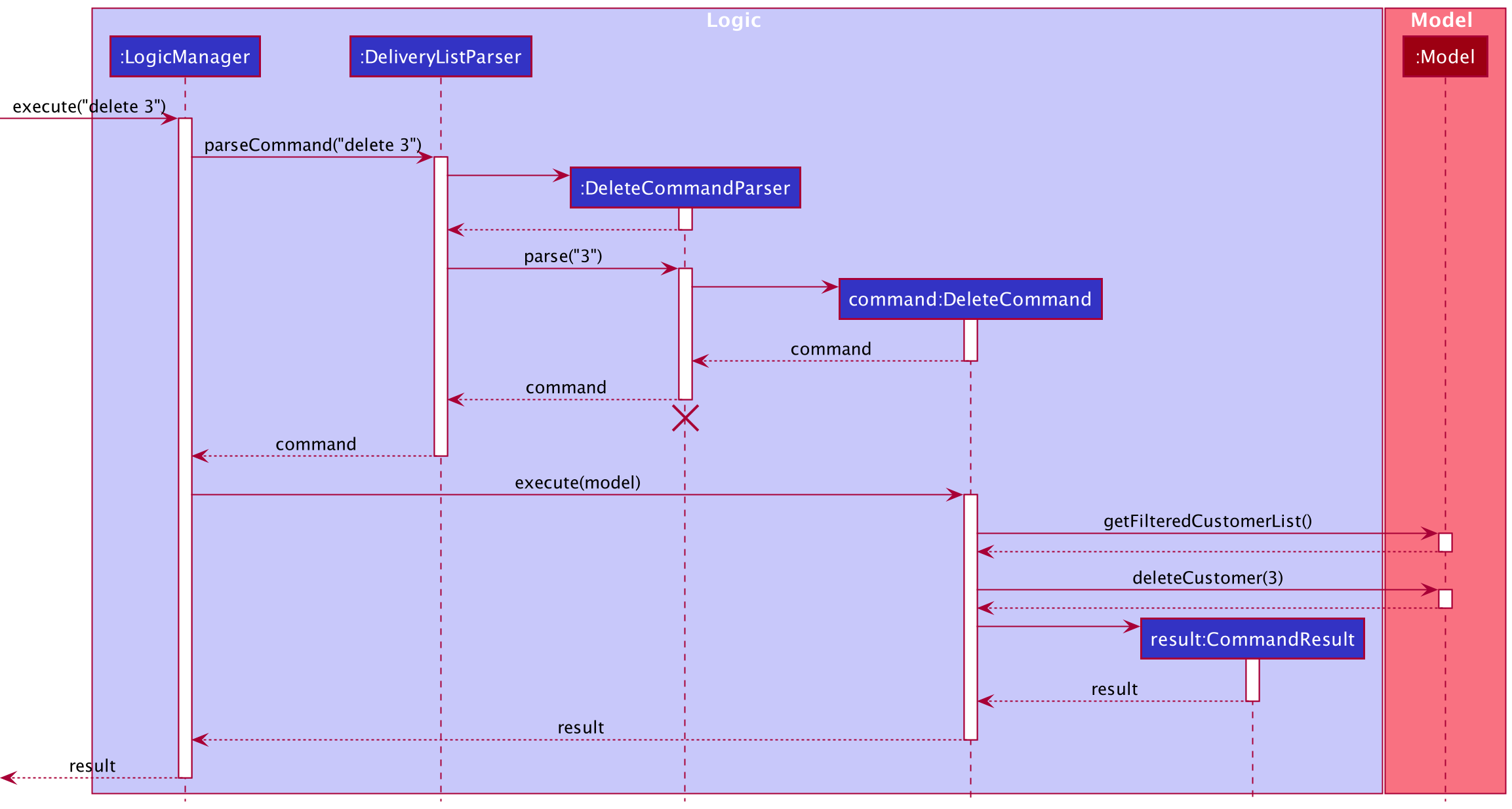
DeleteCommandParser should end at the destroy marker (X) but due to a limitation of PlantUML, the lifeline reaches the end of diagram.
Model component

API : Model.java
The Model,
- stores a
UserPrefobject that represents the user’s preferences. - stores the address book data.
- exposes an unmodifiable
ObservableList<Customer>that can be ‘observed’ e.g. the UI can be bound to this list so that the UI automatically updates when the data in the list change. - does not depend on any of the other three components.
Tag list in the DeliveryList, which Customer references. This allows AddressBook to only require one Tag object per unique Tag, instead of each Person needing their own Tag object.
Storage component

API : Storage.java
The Storage component,
- can save
UserPrefobjects in json format and read it back. - can save the address book data in json format and read it back.
Common classes
Classes used by multiple components are in the seedu.timeforwheels.commons package.
Implementation
This section describes some noteworthy details on how certain features are implemented.
Delete Feature delete
The delete feature allows users to delete a delivery task from the delivery list by using the index in the displayed list.
Implementation
The Sequence Diagram below shows how the components interact when a user enters delete 3 to delete a delivery tasks with task number 3 in the delivery list:
Description:
- When the user keys in the input
delete 3, execute method of LogicManager is called with the input as the parameter. - In the method, LogicManager calls the parseCommand method of DeliveryListParser to parse the user input.
- The DeliveryListParser parses the input and identifies it as a DeleteCommand and instantiates a DeleteCommandParser object.
- DeliveryListParser then calls the parse method of the DeleteCommandParser object to further parse the arguments provided.
- In the parse method, the DeleteCommandParser ensures that the input is of the correct format and identifies the index of the customer to be deleted.
- If the index specified by the user is valid, a new DeleteCommand instance is created and returned to LogicManager via DeliveryListParser.
- The LogicManager will then call the overridden execute method of the DeleteCommand object with Model as the argument.
- Subsequently, the DeleteCommand object will invoke deleteCustomer method of Model with the index of the customer to be deleted as the argument.
- It will then return a CommandResult object to LogicManager. This CommandResult will be returned at the end by LogicManager.
The following Activity Diagram summarizes what happens when a user executes the delete command:

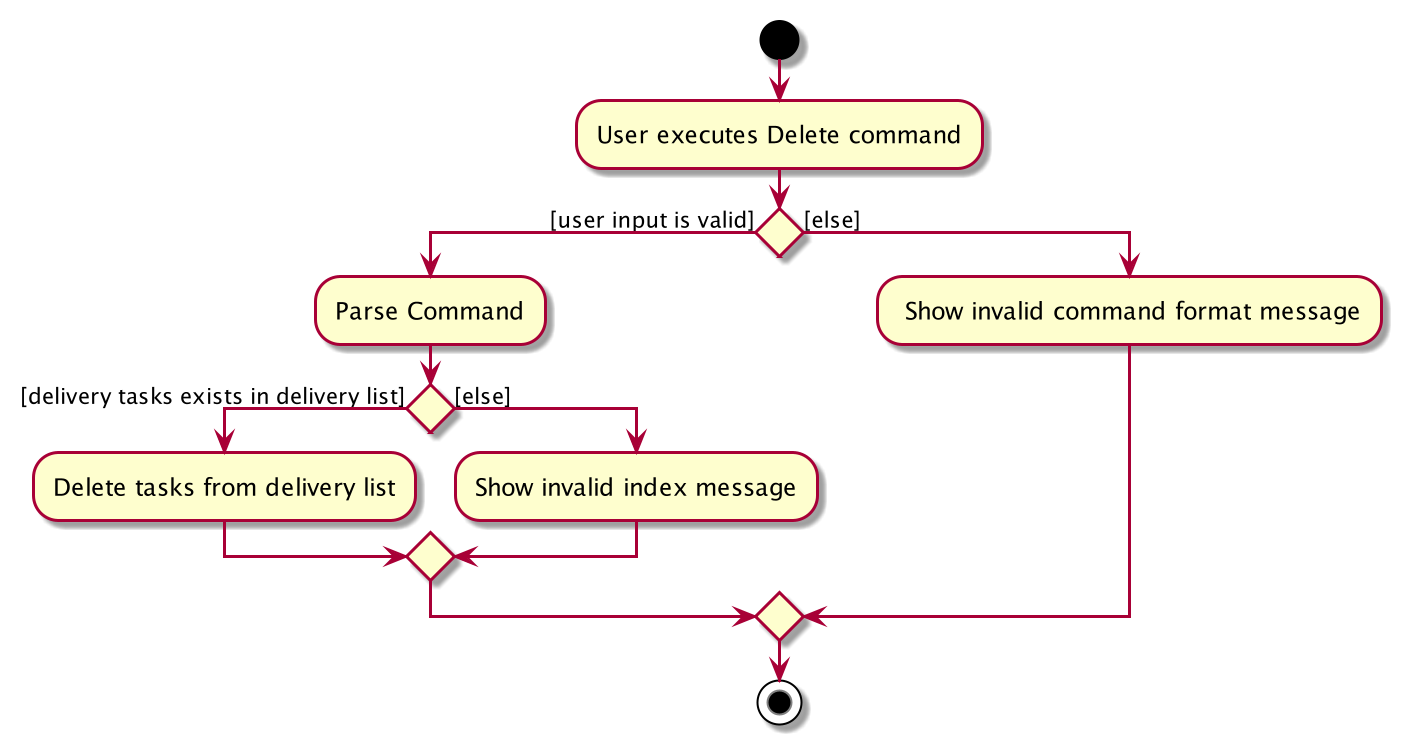
Design consideration:
Aspect: How Delete delivery task executes
Alternative 1 (current choice): Delete delivery task based on the index number shown on the delivery list.
Pros: User can ensure that the correct delivery tasks is deleted as index number is unique to each delivery task
Cons: User is required to look through the list first to find the index of the delivery tasks they wish to delete
Alternative 2: Delete delivery task using name
Pros: User may no longer need to look through the delivery list to find the index number of the task they wish to delete
Cons: If there are duplicates in the name, the wrong delivery task might get deleted. Furthemore, the User has to type a longer command text if the name is long.
Hence, Alternative 1 was chosen because it is less likely to be buggy when in production even though for a larger delivery list, the user may dislike deleting delivery task based on index
Edit Feature edit
The edit feature allows drivers to edit the name, address, email, tag and date of a delivery task from the delivery list using the index/task number of the delivery task
Implementation
The Sequence Diagram below shows how the components interact when a user enters edit 1 n/Jacob to change the name of the first delivery task in the delivery list:
Description:
- When the user keys in the input
edit 1 n/Jacob, execute method of LogicManager is called with the input as the parameter. - In the method, LogicManager calls the parseCommand method of DeliveryListParser to parse the user input.
- The DeliveryListParser parses the input and identifies it as a EditCommand and instantiates a EditCommandParser object.
- DeliveryListParser then calls the parse method of the EditCommandParser object to further parse the arguments provided.
- In the parse method, the EditCommandParser ensures that the input is of the correct format and identifies the index of the item to be edited.
- If both the index and attributes specified by the user is valid, a new EditCommand instance will be created and returned to LogicManager via DeliveryListParser.
- The LogicManager will then call the overridden execute method of the EditCommand object with Model as the argument.
- EditCommand calls the getFilteredCustomerList method of Model to get the customer list. It also calls the createEditedCustomer method to create an edited customer.
- Using the index attribute of the EditCommand object, the customer to be edited from the customer list is retrieved and set to the edited customer.
- Then, EditCommand will create a CommandResult object and return it to LogicManager.
- This CommandResult will be returned at the end by LogicManager.
The following Activity Diagram summarizes what happens when a user executes the edit command:

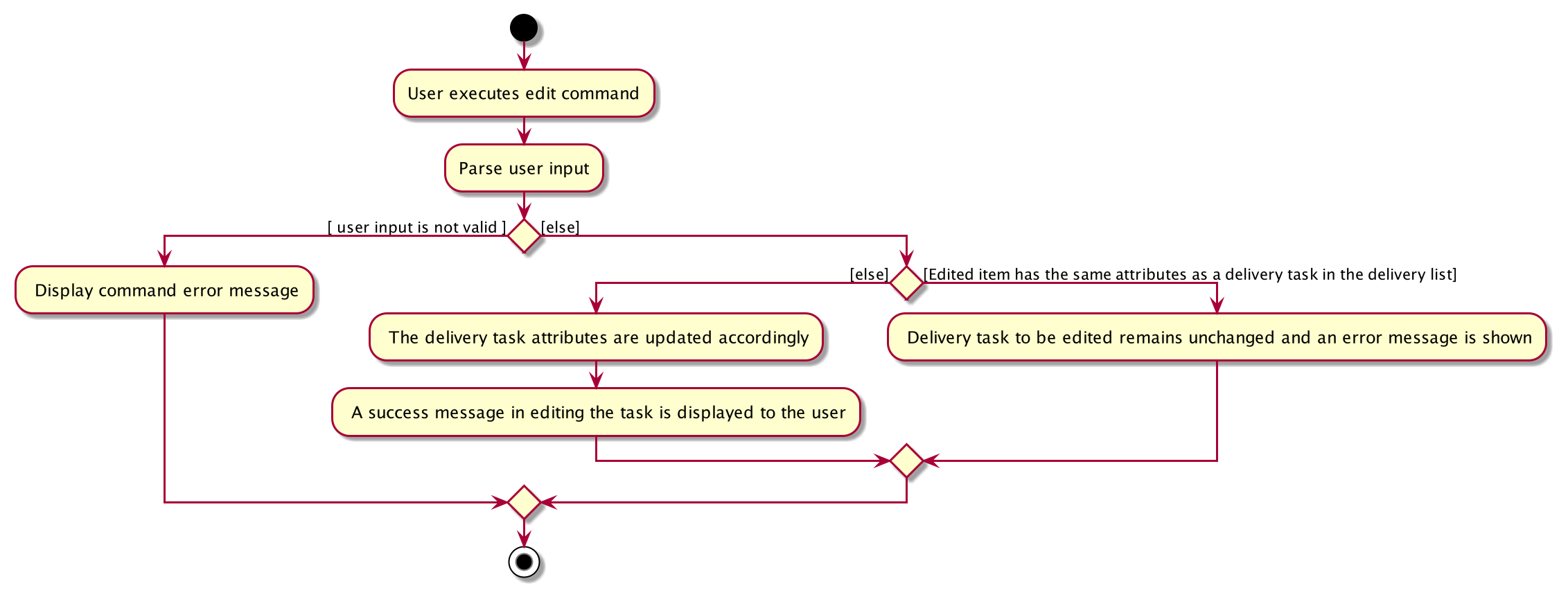
Design consideration:
Aspect: How edit delivery task executes
Alternative 1 (current choice): Edit delivery task based on the index number shown on the delivery list.
Pros: User can ensure that the correct delivery tasks is edit as index number is unique to each delivery task
Cons: User is required to look through the list first to find the index of the delivery tasks they wish to edit
Alternative 2: edit delivery task using name
Pros: User may no longer need to look through the delivery list to find the index number of the task they wish to edit
Cons: If the name is required to be edited, may need to create another new command to edit the name of the delivey task which increase the number of code and testing
Hence, Alternative 1 was chosen because it has less resources for implementation
Find Feature - find KEYWORDS
The find feature allows drivers to find a delivery based on attributes that match the keywords that have been typed in.
Implementation The Sequence Diagram below shows how the components interact when a user enters find Alex to retrieve entries matching the word ALex in the delivery list:
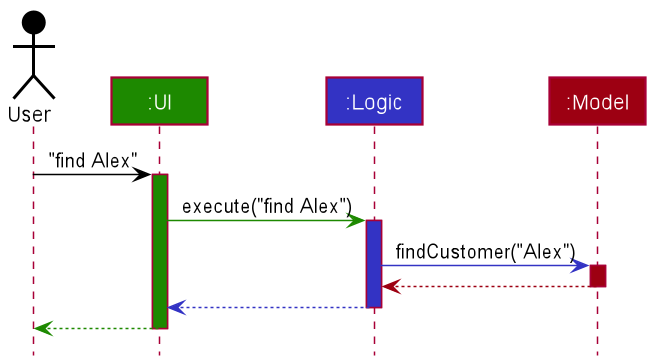
Below is a further breakdown of the logic component of the find command using a sequence diagram
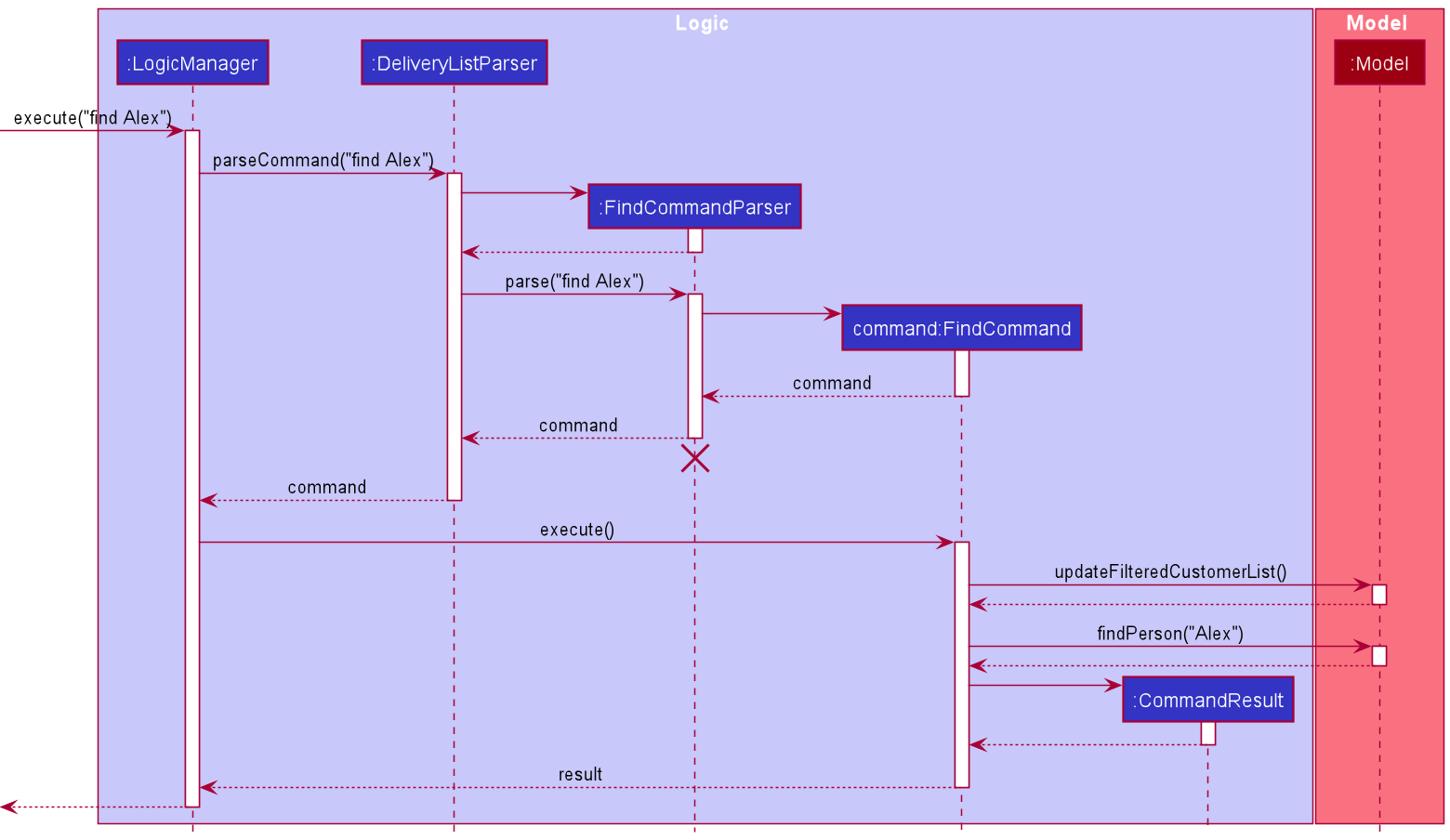
Description:
- When the user keys in an input, execute method of LogicManager is called with the user input as the parameter.
- In the method, LogicManager calls on the parseCommand method of DeliveryListParser to parse the user input.
- The DeliveryListParser parses the user input and identifies it as a FindCommand and instantiates a FindCommandParser object.
- DeliveryistParser then invokes the parse method of the FindCommandParser object to further parse the arguments provided.
- In the parse method, the FindCommandParser ensures that the input is of the correct format and identifies the keywords.
- If the input specified by the user is valid, a new FindCommand instance will be created and returned to LogicManager via DeliveryListParser.
- The LogicManager will then invoke the overridden execute method of the FindCommand object with Model as the argument.
- Subsequently, the FindCommand object will take in the keywords and invoke the updateFilteredCustomersList method of Model that gets the entries with attributes that match the keyword(s).
- It will then return a CommandResult object to LogicManager.
- This CommandResult will be returned at the end by LogicManager.
The following Activity Diagram summarizes what happens when a user executes the find command:
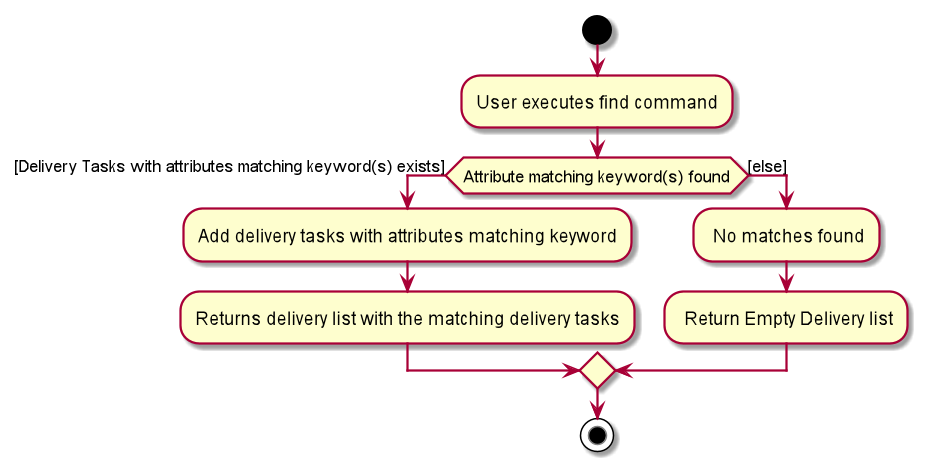
Design consideration:
Aspect: How Find delivery task command executes
Alternative: Find delivery tasks based on the incomplete keywords.
Pros: Wider range of delivery tasks could be retrieved.
Cons: Too many results, which may defeat the purposes of reducing the number of entries to go through.
Remark Command - remark INDEX r/DESCRIPTION
The remark command allows the drivers to add any additional information to the delivery task
Below is a sequence diagram for the remark command.

Description:
- When the user keys in an input, execute method of LogicManager is called with the user input as the parameter.
- In the method, LogicManager calls on the parseCommand method of DeliveryListParser to parse the user input.
- The DeliveryListParser parses the user input and identifies it as a RemarkCommand and instantiates a RemarkCommandParser object.
- DeliveryListParser then invokes the parse method of the RemarkCommandParser object to further parse the arguments provided.
- In the parse method, the RemarkCommandParser ensures that the input is of the correct format and identifies the input for the index of the item for which remark needs to be added.
- If the index specified by the user is valid, a new RemarkCommand instance will be created and returned to LogicManager via DeliveryListParser.
- The LogicManager will then invoke the overridden execute method of the RemarkCommand object with Model as the argument.
- Subsequently, the RemarkCommand object will be created with the index of the item to add remark, and remark description as the argument, and it will invoke the setCustomer method to replace old entry with the new one which contains the remark.
- It will then return a CommandResult object to LogicManager.
- This CommandResult will be returned at the end by LogicManager.
Below is an activity diagram for the remark command.

Design consideration:
Aspect: How Remark delivery task command executes
Alternative: Incorporate a Delivery Description field to remark to only store info on items being delivered.
Pros: Adds a further critetria to the delivery task.
Cons: Reduce flexibility of remark command.
List Command - list
The list command allows users to see all the delivery tasks in the delivery list.

Description: When the user keys the input command “list”, execute method of LogicManager is called. In the method, LogicManager calls on the parseCommand method of DeliveryListParser to parse the command. The DeliveryListParser parses the command and identifies it as a ListCommand which then returns the CommandResult object to the LogicManager. The CommandResult will update the model through the command updatedFilteredCustomerList() to show all the delivery tasks in the delivery list.
The following Activity Diagram summarizes what happens when a user executes the list command:

Help Command - help
The help command allows users to see all the available commands and how to use them
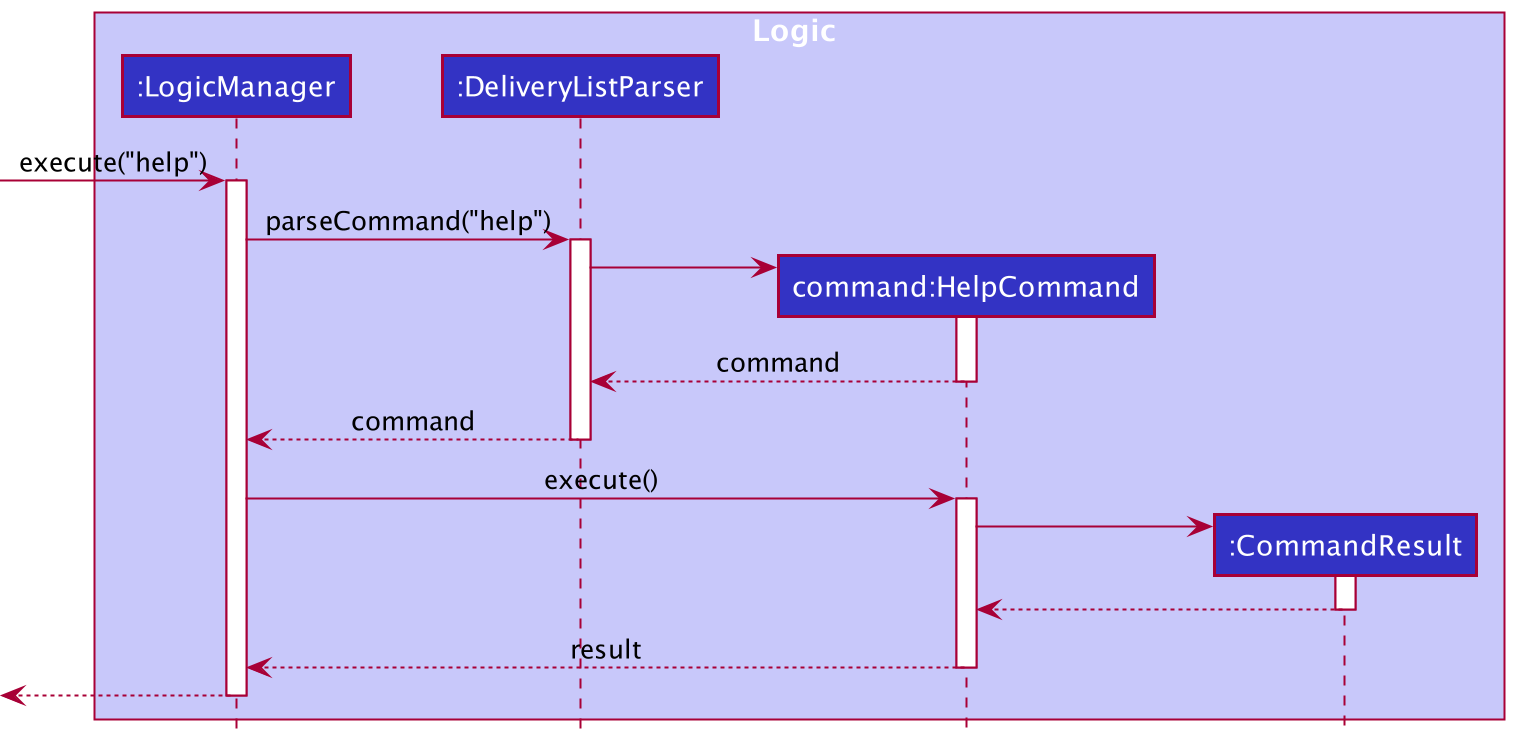
Description: When the user keys the input command “help”, execute method of LogicManager is called. In the method, LogicManager calls on the parseCommand method of DeliveryListParser to parse the command. The DeliveryListParser parses the command and identifies it as a HelpCommand which then returns the CommandResult object to the LogicManager. The CommandResult will update the UI by setting showHelp() to true to show the pop-up help window.
The following Activity Diagram summarizes what happens when a user executes the help command:

Completed Command - completed
The completed command allows users to see all the delivery tasks marked as done.
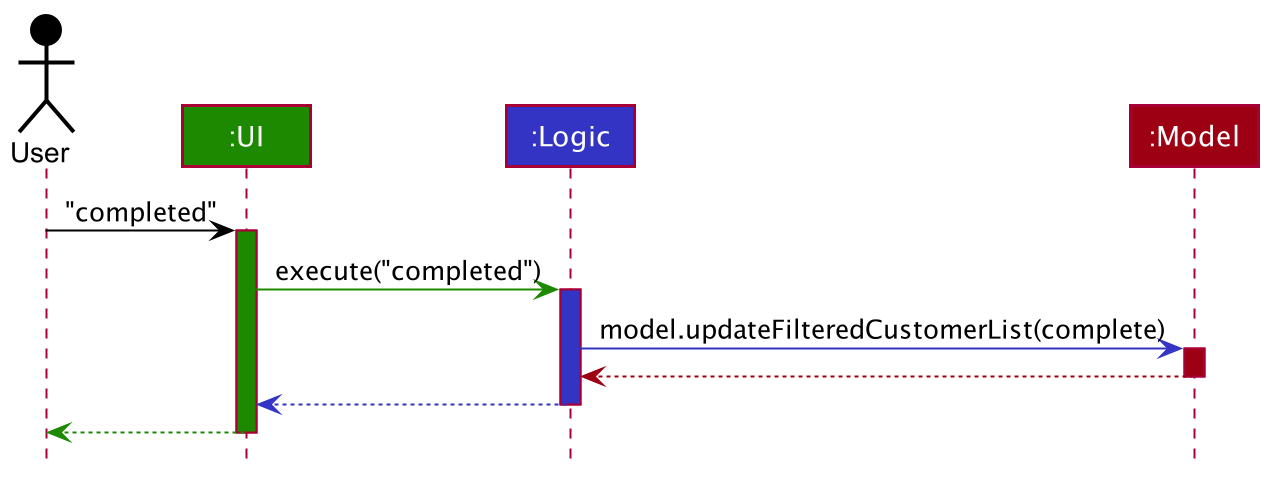
Below is a further breakdown of the logic component of the completed command using a sequence diagram
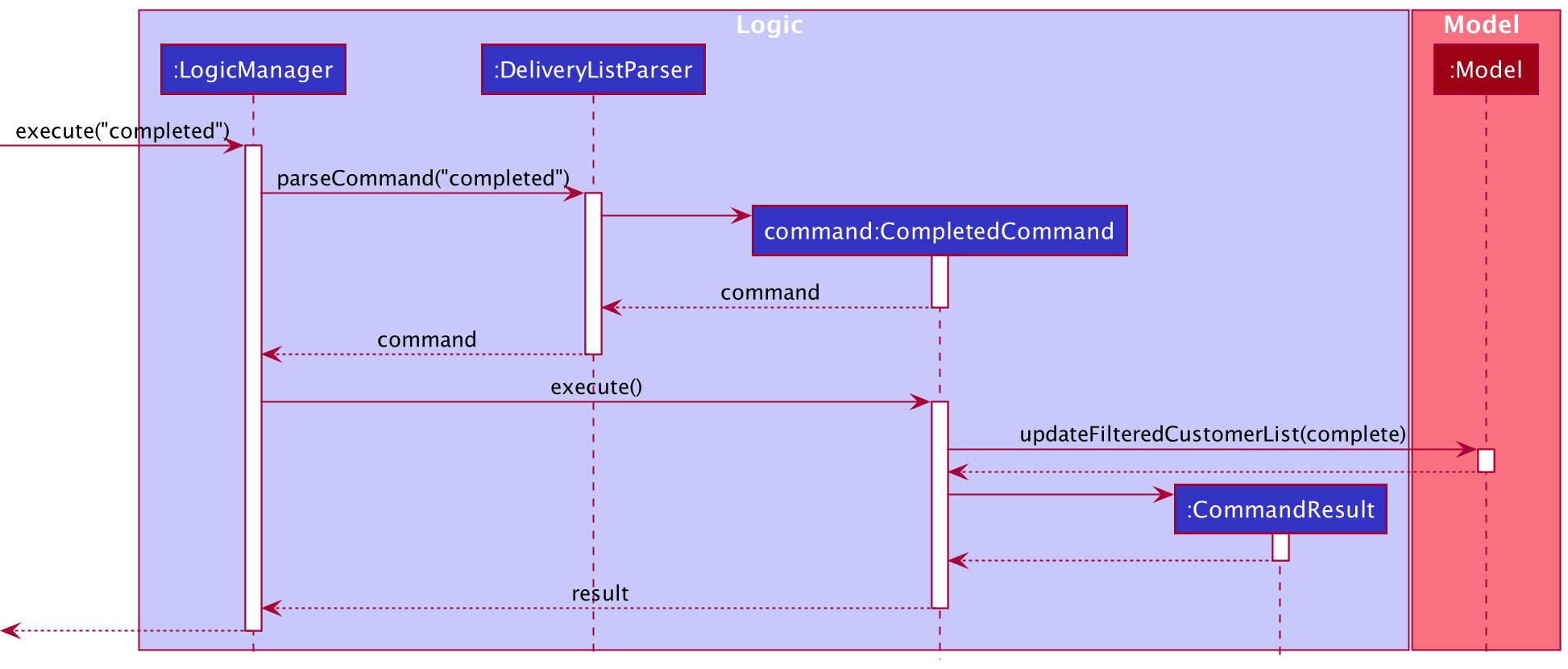
Description: When the user keys the input command “completed”, execute method of LogicManager is called. In the method, LogicManager calls on the parseCommand method of DeliveryListParser to parse the command. The DeliveryListParser parses the command and identifies it as a CompletedCommand which then returns the CommandResult object to the LogicManager. The CommandResult will update the model through the command updatedFilteredCustomerList() to show all the delivery tasks marked done in the delivery list.
The following Activity Diagram summarizes what happens when a user executes the completed command:
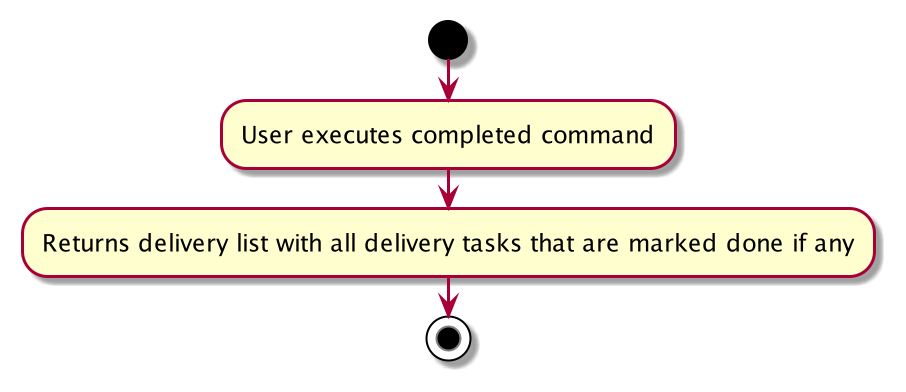
Uncompleted Command - uncompleted
The uncompleted command allows users to see all the delivery tasks not marked as done.
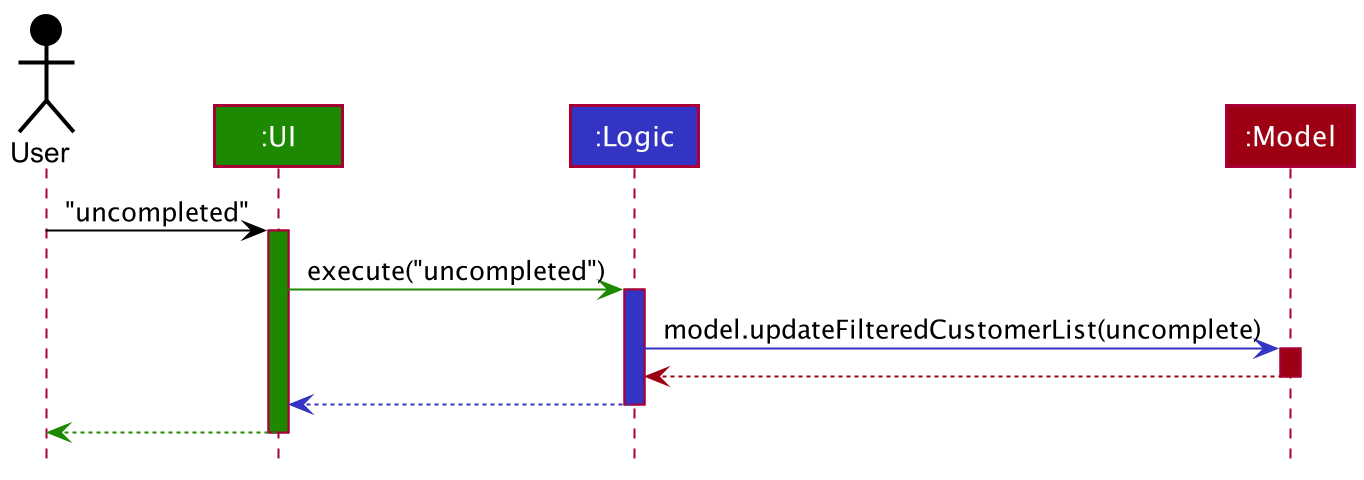
Below is a further breakdown of the logic component of the uncompleted command using a sequence diagram
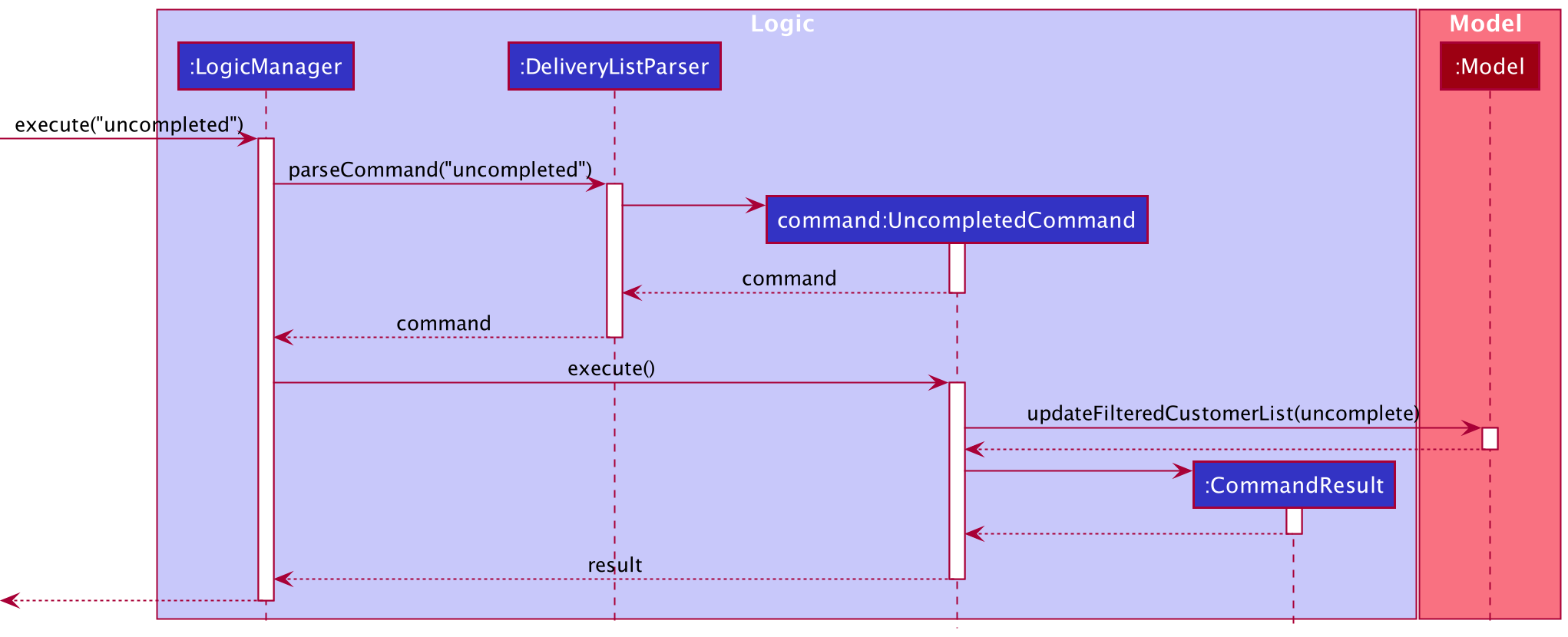
Description: When the user keys the input command “uncompleted”, execute method of LogicManager is called. In the method, LogicManager calls on the parseCommand method of DeliveryListParser to parse the command. The DeliveryListParser parses the command and identifies it as a UncompletedCommand which then returns the CommandResult object to the LogicManager. The CommandResult will update the model through the command updatedFilteredCustomerList() to show all the delivery tasks not marked done in the delivery list.
The following Activity Diagram summarizes what happens when a user executes the uncompleted command:

Add Command - add
The Add command allows drivers to add new delivery tasks to the delivery list.
Below is a sequence diagram for the Add command.
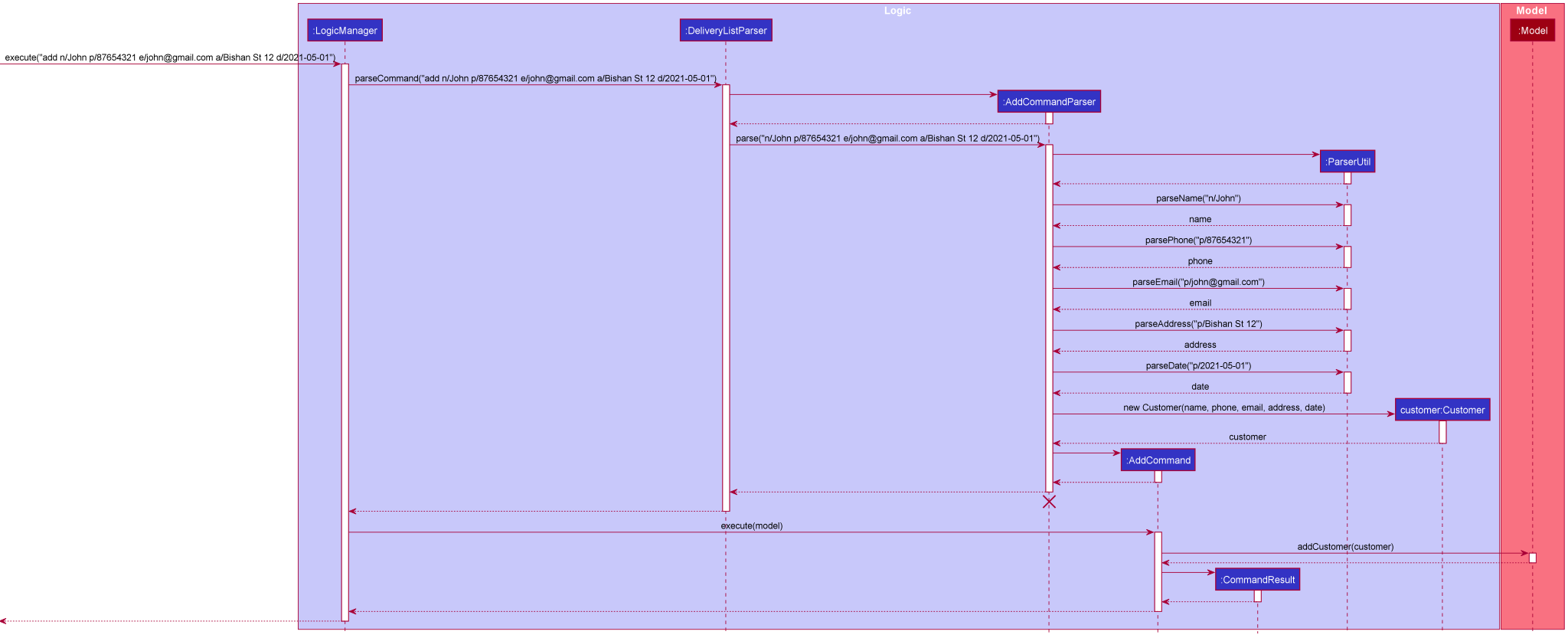
Description: When the user keys in the delivery details, execute method of LogicManager is called with the delivery details as the parameter. In the method, LogicManager calls on the parseCommand method of DeliveryListParser to parse the delivery details. The DeliveryListParser parses the delivery details and identifies it as an AddCommand and instantiates an AddCommandParser object. DeliveryListParser then invokes the parse method of the AddCommandParser object to further parse the details. In the parse method, the AddCommandParser separates the details into segments based on their prefix. Each segment is sent to the ParserUtil, which will return the respective objects representing that segment. The AddCommandParser will create a new customer from the segments and instantiate a new AddCommand object with the customer as the parameter. The AddCommand instance will be returned to LogicManager via DeliveryListParser. The LogicManager will then invoke the overridden execute method of the AddCommand object with Model as the argument. Subsequently, the AddCommand object will add the customer to the Model. It will then return a new CommandResult object to LogicManager, which will then be returned at the end by LogicManager.
Below is an activity diagram for the remark command.

Sort Command - sort
The Sort command allows users to see all the delivery tasks in the delivery list but sorted by completion status (incomplete tasks shown first), then by urgency (only for incomplete tasks), and lastly by date.
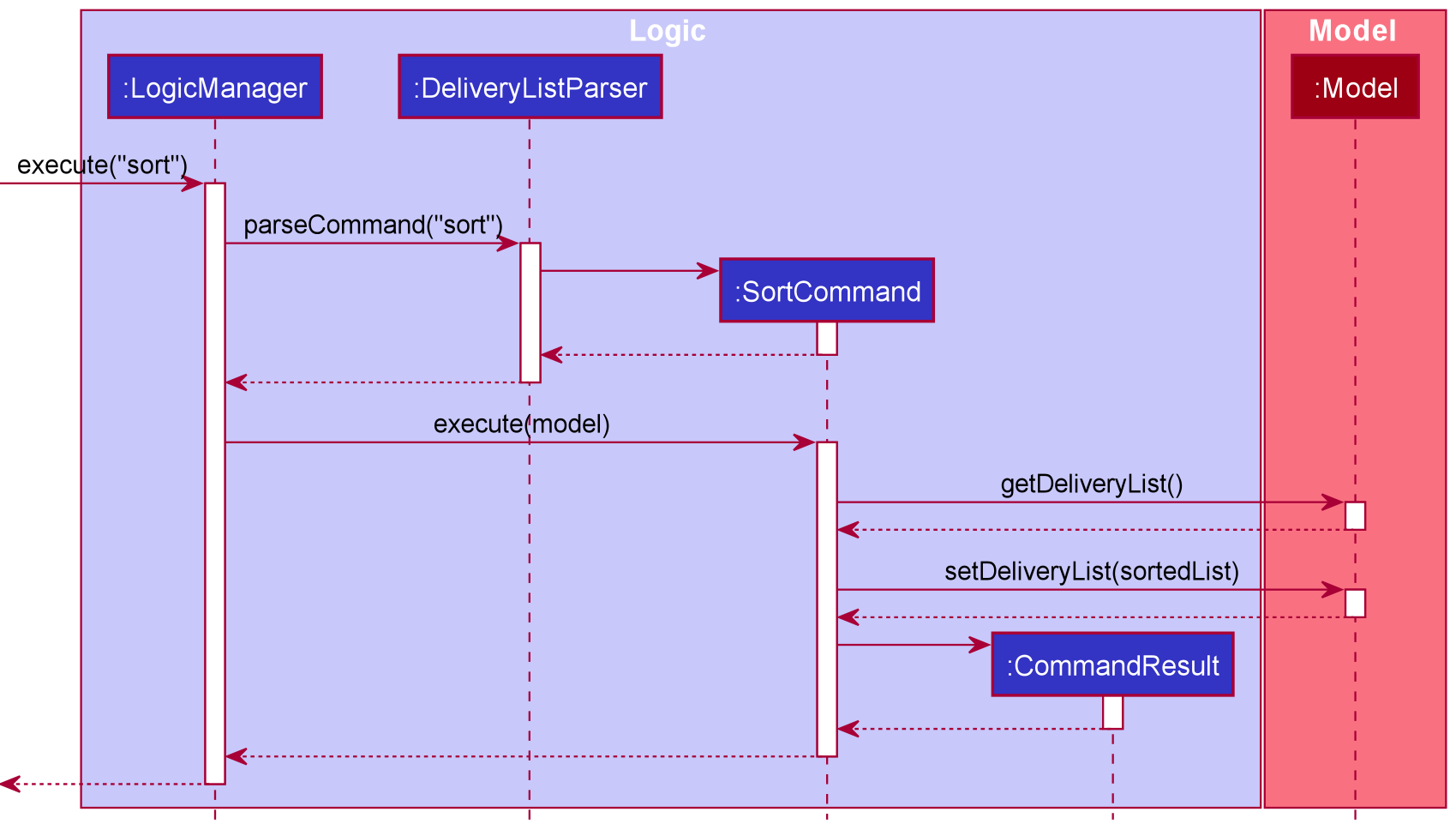
Description: When the user keys the input command “sort”, execute method of LogicManager is called. In the method, LogicManager calls on the parseCommand method of DeliveryListParser to parse the command. The DeliveryListParser parses the command and identifies it as a SortCommand and will then create a SortCommand instance. The SortCommand instance will be returned to LogicManager via DeliveryListParser. The LogicManager will then invoke the overridden execute method of the SortCommand object with Model as the argument. Subsequently, the SortCommand object will get the latest delivery list from the model and sort it before setting the sorted delivery list as the latest one. The SortCommand object will return a new CommandResult object to the LogicManager, which will then be returned at the end by LogicManager.
The following Activity Diagram summarizes what happens when a user executes the list command:
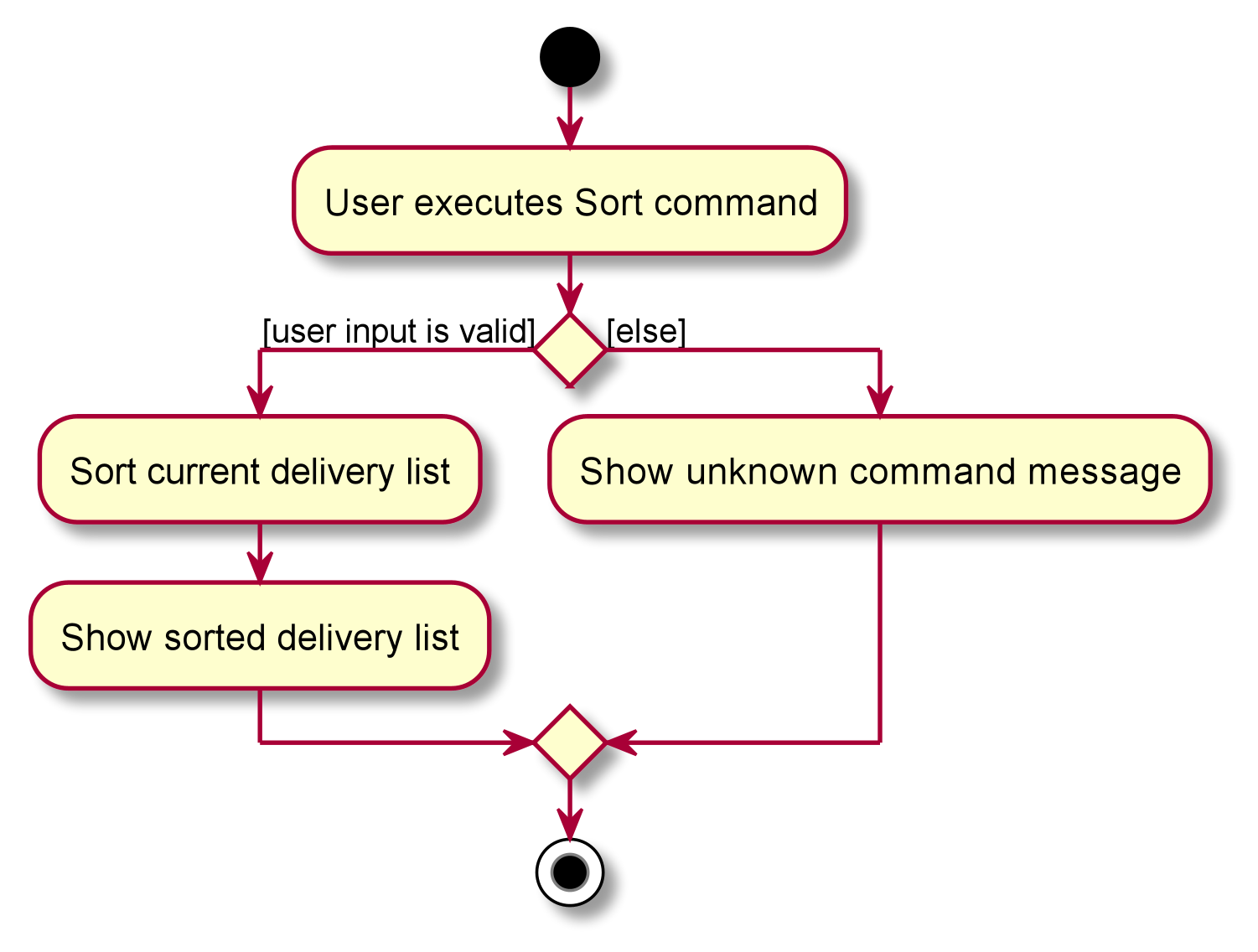
Clear Command - clear
The Clear command allows users to delete all existing delivery tasks at one go.

Description: When the user keys the input command “clear”, execute method of LogicManager is called. In the method, LogicManager calls on the parseCommand method of DeliveryListParser to parse the command. The DeliveryListParser parses the command and identifies it as a ClearCommand and will then create a ClearCommand instance. The ClearCommand instance will be returned to LogicManager via DeliveryListParser. The LogicManager will then invoke the overridden execute method of the ClearCommand object with Model as the argument. Subsequently, the ClearCommand object will set a new empty delivery list as the latest one in the model. The ClearCommand object will return a new CommandResult object to the LogicManager, which will then be returned at the end by LogicManager.
The following Activity Diagram summarizes what happens when a user executes the list command:
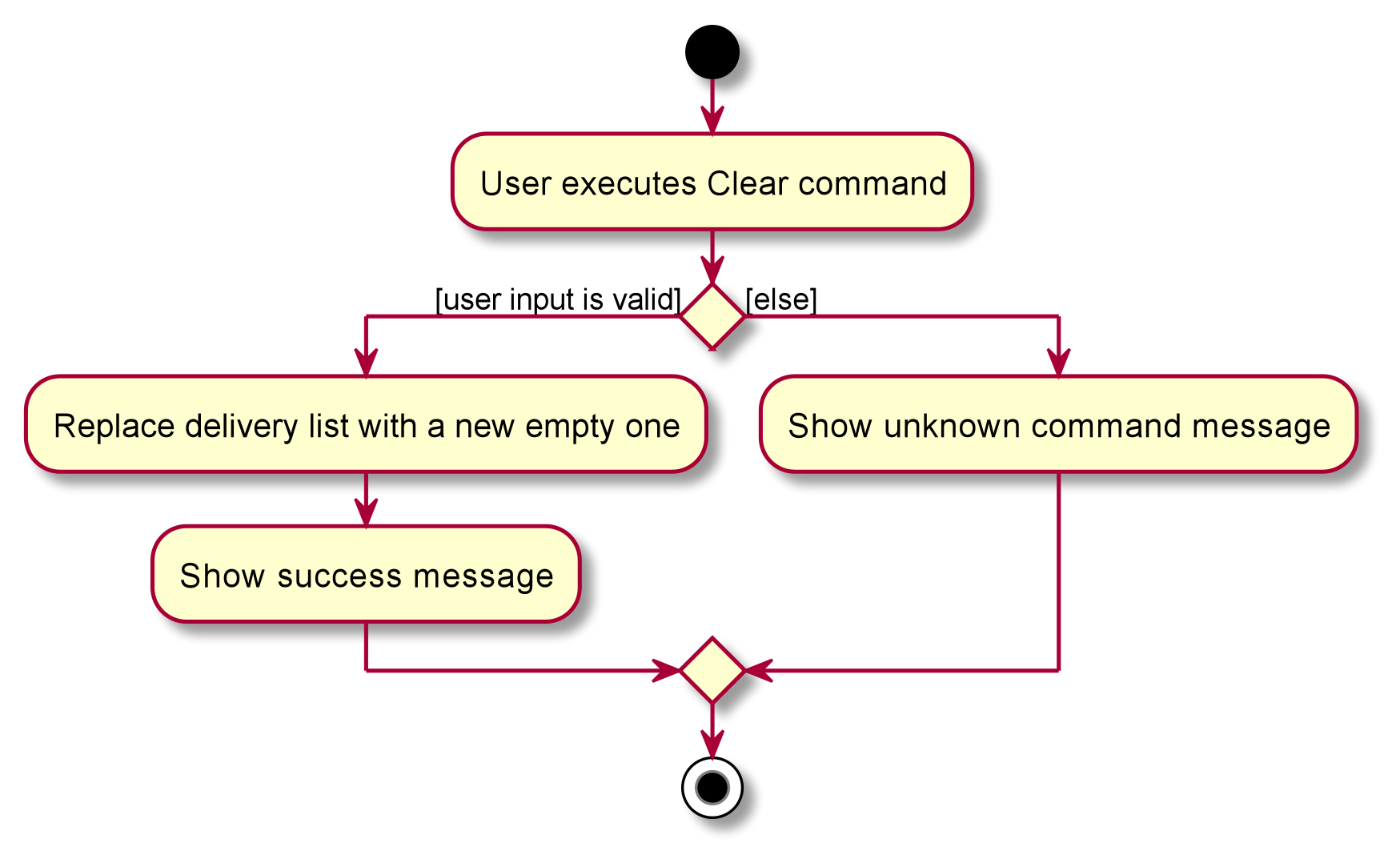
Documentation, logging, testing, configuration, dev-ops
Appendix: Requirements
Product scope
Target user profile:
- Freelance delivery drivers and companies that conduct delivery operations.
- Domestic and not international delivery.
- Delivery on land (car, motorcycle, bicycle, foot) and not on sea (ships) or in the air (planes).
- Need to manage many delivery entries and their respective details.
- Need to personally manage their own deliveries.
- Prefers navigating using the keyboard to mouse interactions.
- Can type fast.
- Has basic experience and knowledge in using CLI apps.
- Prefers using desktop app to other types when managing their workflow.
Value proposition: manage delivery workflows and details faster than a typical mouse/GUI driven app for greater efficiency
User stories
Priorities: High (must have) - * * *, Medium (nice to have) - * *, Low (unlikely to have) - *
| Priority | As a … | I want to … | So that I can… |
|---|---|---|---|
* * * |
Delivery driver | Add a delivery task to the list. | Keep track of all the deliveries I am supposed to make. |
* * * |
Delivery driver | Delete a delivery task from the list. | Remove completed deliveries or unwanted deliveries I do not want to make. |
* * * |
Delivery driver | Edit a delivery task in the list. | Make necessary changes to the delivery details. |
* * * |
Delivery driver | Exit the app. | Close the application when I am not using it |
* * * |
Delivery driver | Find all delivery tasks by keyword(s). | Get all the deliveries with details containing the keyword(s). |
* * * |
Delivery driver | Get the list of all my delivery tasks. | See all the deliveries that i have. |
* * |
Delivery driver | Mark a delivery task in the list as done. | Keep track of which deliveries I have done. |
* * |
Delivery driver | Clear all delivery tasks from the list. | Clean or reset my delivery list. |
* * |
Delivery driver | Get help for issues pertaining to the app. | Understand the app’s features and how to use them better. |
* * |
Delivery driver | Get the list of all my completed delivery tasks. | See all the deliveries I have done. |
* * |
Delivery driver | Get the list of all my uncompleted delivery tasks. | See all the deliveries I have not done. |
* * |
Delivery driver | Add a tag to a delivery task in the list. | Add information categorising the parcel for that delivery. |
* * |
Delivery driver | Delete all tags from a delivery task in the list. | Delete the information categorising the parcel for that delivery. |
* * |
Delivery driver | Edit the tags of a delivery task in the list. | Edit the information categorising the parcel for that delivery. |
* * |
Delivery driver | Sort the delivery tasks in the list. | See the delivery tasks that i have to do first easily |
{More to be added}
Use cases
For all use cases, our Software System and Actor are as stated below: Software System: Delivery App
Actor: Delivery driver (app user)
Use case: UC01 - Add a delivery task to the list.
Guarantees:
- Adding a new delivery task to the list.
MSS
- User enters the delivery task to be added to the list.
-
TimeForWheels App adds the delivery task to the list and informs the User.
Use case ends.
Extensions
- 1a. The delivery entry to be added has an invalid format.
- 1a1. TimeForWheels App requests for a valid delivery task.
- 1a2. User enters new delivery task details.
Steps 1a1-1a2 are repeated until the valid details are entered.
Use case resumes from step 2.
- 2b. The delivery task to be added already exists in the delivery list.
- 2b1. TimeForWheels App informs the User of the duplicate delivery task.
Use case ends.
Use case: UC02 - Delete a delivery task from the list.
Guarantees:
- Deleting the delivery task from the list.
MSS
- User indicates which delivery task to be deleted by entering the task number.
-
TimeForWheels App removes that delivery entry from the list and informs the User.
Use case ends.
Extensions
- 1a. The task number of the delivery task is invalid.
- 1a1. User enters a new task number.
Step 1a1 is repeated until the valid task number is entered.
Use case resumes from step 2.
Use case: UC03 - Edit a delivery task in the list.
Guarantees:
- Editing and updating the selected existing delivery task in the list.
MSS
- User indicates which delivery task to edit by entering the task number.
- User enters the updated details.
-
TimeForWheels App replaces the old delivery entry with the updated one and informs the User.
Use case ends.
Extensions
- 1a. The task number of the delivery task is invalid.
- 1a1. User enters new task number.
Step 1a1 is repeated until the valid task number is entered.
Use case resumes from step 2.
- 2a. The updated details have an invalid format.
- 2a1. User enters new details.
Step1 2a1 is repeated until the valid details are entered.
Use case resumes from step 3.
- 3a. The edited delivery task already exists in the delivery list.
- 3a1. TimeForWheels App informs the User of the duplicate delivery task.
Use case ends.
Use case: UC04 - Exit the app.
Guarantees:
- Closing TimeForWheels.
MSS
- User indicates to quit the app.
-
Delivery App exits.
Use case ends.
Use case: UC05 - Find all delivery entries by the keyword(s) that match an attribute.
Guarantees:
- Getting the list of existing delivery tasks with attributes matching the specified keyword(s).
MSS
- User enters the keyword(s).
-
TimeForWheels App lists out all existing delivery tasks with attributes matching the specified keyword(s).
Use case ends.
Extensions
- 1a. The list is empty.
- 1a1. TimeForWheels App informs the User that the delivery list is empty.
Use case ends.
- 1b. There are no delivery entries with the matching keyword(s).
- 1b1. TimeForWheels App informs the User that there are no delivery tasks with details containing the specified keyword(s).
Use case ends.
Use case: UC06 - Get the list of all my delivery tasks.
Guarantees:
- Getting the list of all existing delivery tasks.
MSS
- User requests to see all delivery tasks in the list.
-
TimeForWheels App lists out all existing delivery tasks.
Use case ends.
Extensions
- 1a. The list is empty.
- 1a1. TimeForWheels App informs the User that the list is empty.
Use case ends.
Use case: UC07 - Get the list of all my completed delivery tasks.
Guarantees:
- Getting the list of all completed delivery tasks.
MSS
- User requests to see all completed delivery tasks in the list.
-
TimeForWheels App lists out all delivery tasks that are marked as done.
Use case ends.
Extensions
- 1a. The list is empty.
- 1a1. TimeForWheels App informs the User that the list is empty.
- 1b. There are no delivery tasks in the list that are marked as done.
- 1b1. TimeForWheels App informs the User that there are no completed delivery tasks in the list.
Use case ends.
Non-Functional Requirements
-
Usability:
- Should work on any mainstream OS as long as it has Java
11or above installed. - A user with above average typing speed for regular English text (i.e. not code, not system admin commands) should be able to accomplish most of the tasks faster using commands than using the mouse.
- Should work on any mainstream OS as long as it has Java
-
Reliability:
- Should be able to hold up to 1000 delivery entries and display all data if requested by the user in less than 5 seconds.
- Should be able to detect and inform users of duplicate delivery entries.
-
Security:
- Users that request for any delivery entry data to be deleted will have the data permanently erased from memory.
-
Integrity
- For any time-related data presented to the user, the date formats will be
YYYY-MM-DD. - Delivery entries made by the user will be stored in a JSON file inside the hard disks.
- For any time-related data presented to the user, the date formats will be
-
Flexibility
- TimeforWheels should be able to make it easy for users to find the delivery information stored inside such as name, date, address, tags etc.
{More to be added}
Glossary
- Mainstream OS: Windows, Linux, Unix, OS-X
- Private contact detail: A contact detail that is not meant to be shared with others
- JSON: JavaScript Object Notation
Appendix: Instructions for manual testing
Given below are instructions to test the app manually.
Launch and shutdown
-
Initial launch
-
Download the jar file and copy into an empty folder
-
Double-click the jar file Expected: Shows the GUI with a set of sample contacts. The window size may not be optimum.
-
-
Saving window preferences
-
Resize the window to an optimum size. Move the window to a different location. Close the window.
-
Re-launch the app by double-clicking the jar file.
Expected: The most recent window size and location is retained.
-
Deleting a delivery task
-
Deleting a delivery task
-
Prerequisites: TimeforWheels sample data is loaded in the app. List all delivery task using the
listcommand. -
Test case:
delete 1
Expected: First delivery task is deleted from the list. Details of the deleted task shown in the status message. -
Test case:
delete 0
Expected: No delivery task is deleted. Error details shown in the status message. -
Other incorrect delete commands to try:
delete,delete x,...(where x is larger than the list size)
Expected: Similar to previous.
-
Adding a delivery task
-
Adding a delivery task
-
Test case:
add n/Jacob p/97452637 a/108 Bishan Street e/jacob@gmail.com d/2021-11-10
Expected: Delivery task is added -
Test case:
add n/Jacob p/97452637 a/108 Bishan Street e/jacob@gmail.com
Expected: Invalid command format will be returned as date field is missing.
-
Editing a delivery task
-
Editing a delivery task in the delivery list
-
Prerequisites: TimeforWheels sample data is loaded in the app. List all delivery task using the
listcommand. -
Test case:
edit 1 n/Jacob
Expected: Name for the First delivery task is changed from Alex Yeoh to Jacob. Details of the edited task shown in the status message. -
Test case:
edit 1 p/87348970 e/jacob@example.com a/Blk 30 Bukit Batok 29 #05-40
Expected: Phone, Email, Address of the first delivery task is changed to 87348970, jacob@example.com and Blk 30 Bukit Batok 29 #05-40 respectively. -
Test case:
edit 0 n/John
Expected: No delivery task is edited. Error message shown in the status message. -
Test case:
edit 2 d/2021-13-05
Expected: No delivery task is edited. Error message indicating that Dates should be of the format YYYY-MM-DD is shown -
Other incorrect delete commands to try:
edit,edit x,...(where x is larger than the list size)
Expected: Similar to previous.
-
Finding all completed delivery tasks in the list
1.Prerequisites: TimeforWheels sample data is loaded in the app. List all delivery task using the list command.
1.Test case: completed
Expected : Delivery tasks with name “Alex Yeoh”,”Charlotte Oliveiro”,”Irfan Ibrahim” should be shown.
Finding all uncompleted delivery tasks in the list
1.Prerequisites: TimeforWheels sample data is loaded in the app. List all delivery task using the list command.
1.Test case: uncompleted
Expected : Delivery tasks with name “Bernice Yu”,”David Li”,”Roy Balakrishnan” should be shown.
Finding a delivery task
-
Finding a delivery task in the delivery list
-
Prerequisites: TimeforWheels sample data is loaded in the app. List all delivery task using the
listcommand. -
Test case:
find
Expected: Invalid command format -
Test case:
find Alex
Expected: Delivery Tasks with attributes matching the keyword Alex. -
Test case:
find Alex 2021-10-10
Expected: Delivery Tasks with attributes matching the keyword Alex and the date 10th October 2021.
-